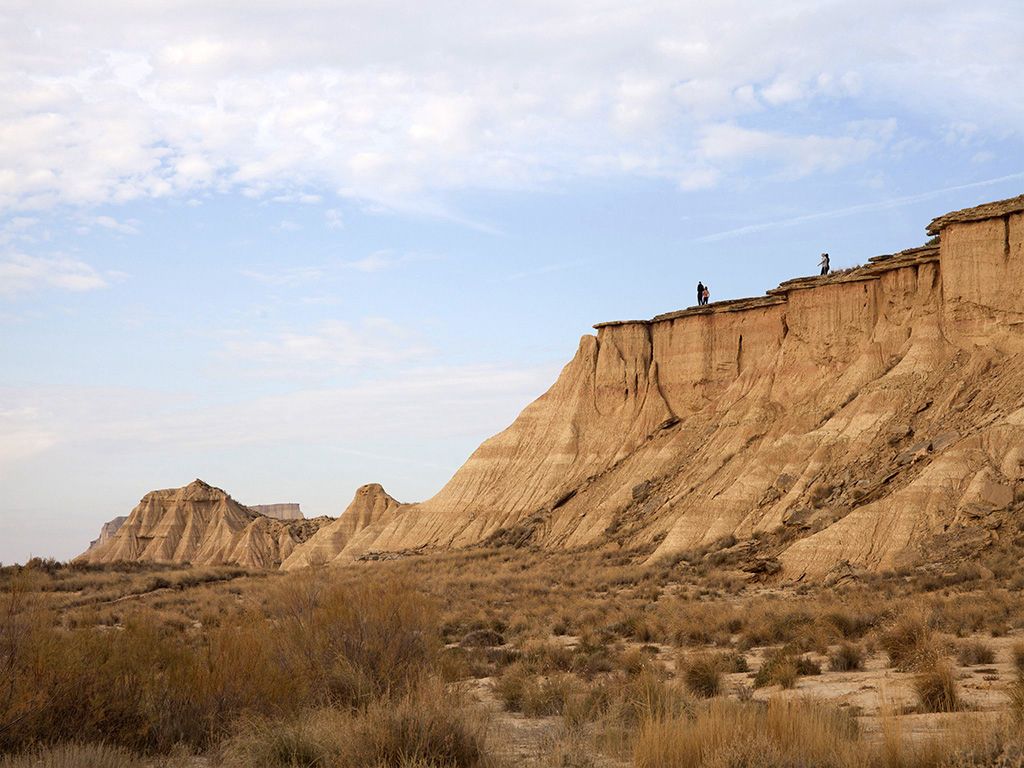

Audio 1. WELCOME. LA BLANCA LOOKOUT.
We welcome you to Royal Bardenas Nature Park. Biosphere Reserve.
We find ourselves with the audioguide at La Blanca Lookout, the Balcony of Bardena. Located at the high point of Aguilares, the exceptional panorama offers us an overall view of the Nature Park, which we’ll soon be discovering, and, we hope, where you’ll be seduced by its features.
The striking scenery of Bardena is the result of the geologic material that makes up its soils, as well as its climate. Distinctly hard materials (limestone, sandstone and conglomerate rock) alternate with those that are soft (loam, clay, silt and gypsum) and this has brought about a rapid and intense erosion.
The result is a great depression called La Blanca, surrounded by a set of reliefs in the form of tablelands. El Plano is a large plateau, which we can see to our left and which faces north. El Plano is 500 meters above sea level. To our right, facing south, are a series of staggered planes, the greatest example being La Plana de la Negra (The Black Plane), at 650 meters above sea level.
In the large La Blanca depression (in front of us) we find hills or hillocks, as in the case of El Rallón (the bothersome one), La Ralla (the one who grates), Las Cortinas (the curtains), Cortinillas (lace curtains) or Los Tres Hermanos (The Three Brothers), which have come about due to a disconnected distribution of sandstone, clay and silt. This arrangement enhances the erosion of the soil, resulting in mounds of clay. The mounds are protected from further erosion by the presence on the top of hard material (sandstone, limestone or conglomerate rock).
La Blanca, at 300 meters above sea level, is the most eroded region of Bardenas. Authentic “Bad Lands” are formed here, owing to the lack of hard layers which are capable of protecting clays.
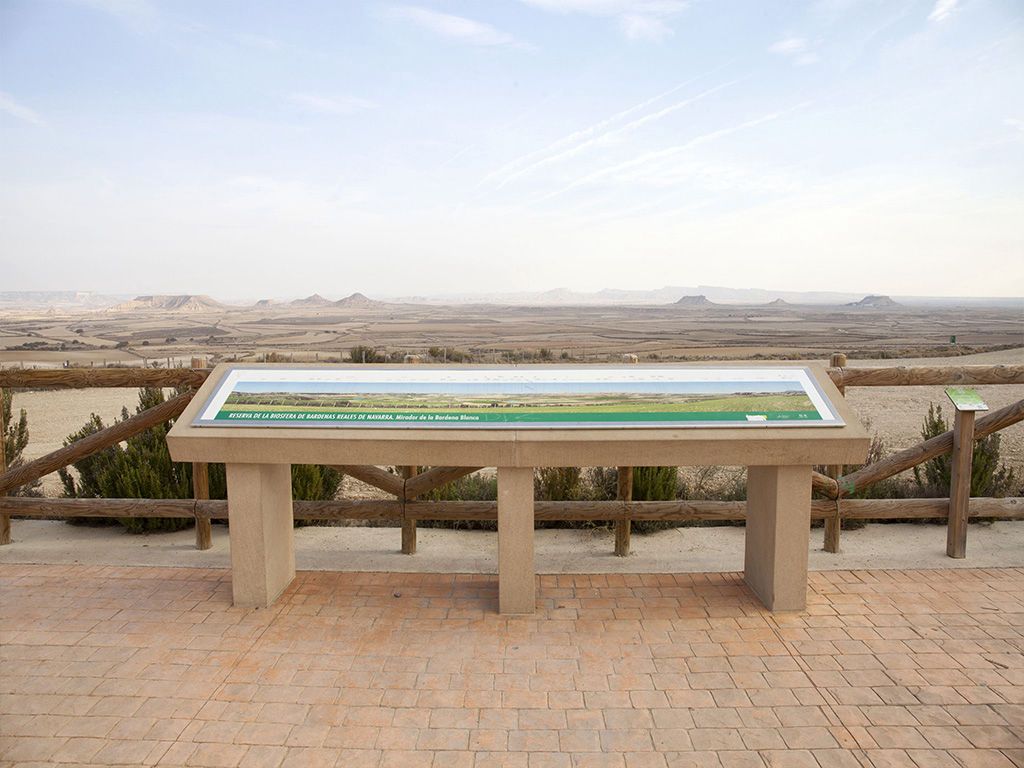
Audio 2. THE ORIGIN OF BARDENAS
The scenery of Bardenas is reflected in its geologic history over the past 20 million years, that you are going to discover in this section of this audioguide. During this time span, Bardenas went through two major phases: the first one was sedimentary, in which a large amount material accumulated. This took place during the Tertiary Period; The second phase took place during the Quaternary Period, in which erosion was very intense.
During the Tertiary Period, Alpine orogeny—the process of mountain-forming-- began 80 million years ago and ended about 10 million years ago. The collision of the Iberian and European plates resulted in the formation of the Pyrenees Mountains (on clear days, one can see them on the horizon), as well as the Iberian Range, represented, behind us, by El Moncayo, and the Coastal-Catalan Range. The progressive rising of these three ranges brought about the complete isolation of the depression that had between them. This lower area is now known as the Ebro Basin. At this moment, some 35 million years ago, the connection to the sea was cut off. This meant that the vast amount of water from rivers and mountain streams could no longer flow to the Mediterranean Sea. The water was trapped in lakes and wetlands along the Great Basin.
The eroded materials in the mountains were carried by waterways towards the centre of the basin, where they were deposited according to their weight and the reduction in water speed: first gravel, then sand, clay and, eventually, silt. With the passage of time, and by the pressure of its own weight, sediments were brought together and became rock: gravel became conglomerate rock; sand became sandstone; silt and clay became shale; in aquatic environments, under various chemical processes, limestones were formed, and, when there was enough salt, gypsum was formed.
The accumulated sedimentary deposit in Bardenas is between 21 and 15 million years old, with a depth of 700 meters.
In the Quaternary Period, some 9 or 10 million years ago, erosion of the Coastal-Catalan range resulted in an opening from the basin to the Mediterranean. This change meant that the water, which until that time had been accumulated in the form of lakes, could drain into the sea. This was the creation of the current river system consisting of the Ebro River and its main tributaries. This marked a shift to a period characterized by widespread erosion and the transportation of materials to the Mediterranean, which continues today.
Erosion continues to take place, being more intense in fragile clay substrates. The most resistant levels (conglomerate rock, sandstone and limestone) protect the clay below from being eroded. The result is the formation of hillocks, such as Castildetierra, Pisquerra, El Rallón, Balcón de Pilatos, El Fraile or La Negra… We will identify these hillocks at the information panel.
What is the significance of ten million years of geologic history. It’s really just a breath in time. If we compare geologic history with a calendar year, Bardenas would have begun to form on December 30 at 9 in the morning, and the first inhabitants would have started living there at 11:59 in the evening of December 31.
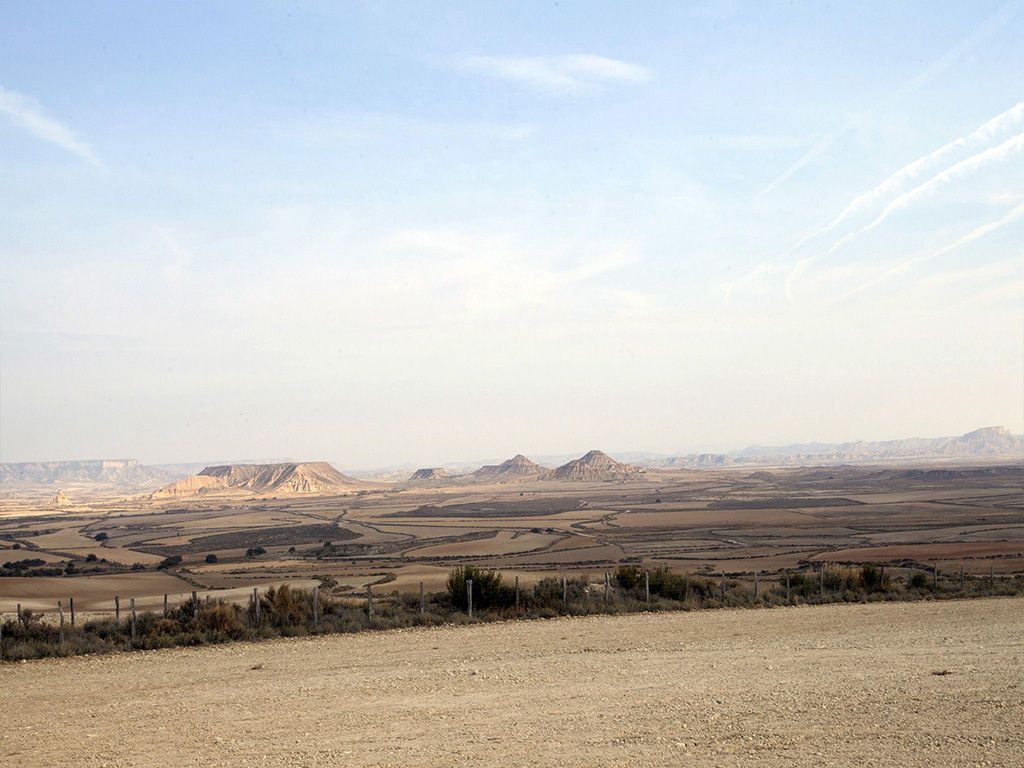
Audio 3. THE HILLOCKS OF THE THREE BROTHERS AND THE MILLITARY BARRACKS.
We find ourselves with the audioguide in the region of “Los Tres Hermanos” (The Three Brothers), which is a striking example of how varied erosion--that is to say the erosion of some materials at a faster rate than others-- has resulted in the formation of both higher elevations (hillocks or hills)—and where most of the ground has been carved lower and lower—all in the same area. The closeness of the three hills allows one to see how the layers of strata continue to flow smoothly from one to another. One can use the imagination to rebuild a larger mountain of which only the hillocks known as the Three Brothers remain.
With the leftmost hillock, we can see its use in livestock farming, as there is a corral at its base. On occasion, we can see griffon vultures perched on the highest points of sandstone, waiting for the farmer to dispose of any carcasses.
The second of the Three Brothers, located in the middle, is a clay hillock, topped by a protective sandstone plate, reminding one of a beret or hat. Little by little, time and erosion will do their work, reducing the width of this hillock, making it increasingly resemble the most emblematic hill of Bardenas: Castildetierra.
On this “brother,” there is a farm, the purpose of which is the recovery of game species. It is a good example of the effort the Bardenas Community and the Association of Hunters and Fishermen of Royal Bardenas are making in the recovery of species such as rabbit—so scarce in La Blanca, but also so necessary as a natural prey for many meat-eating animals.
And finally, on the “Brother” furthest to the right, we can see the facilities of the military barracks, where they operate a firing range.
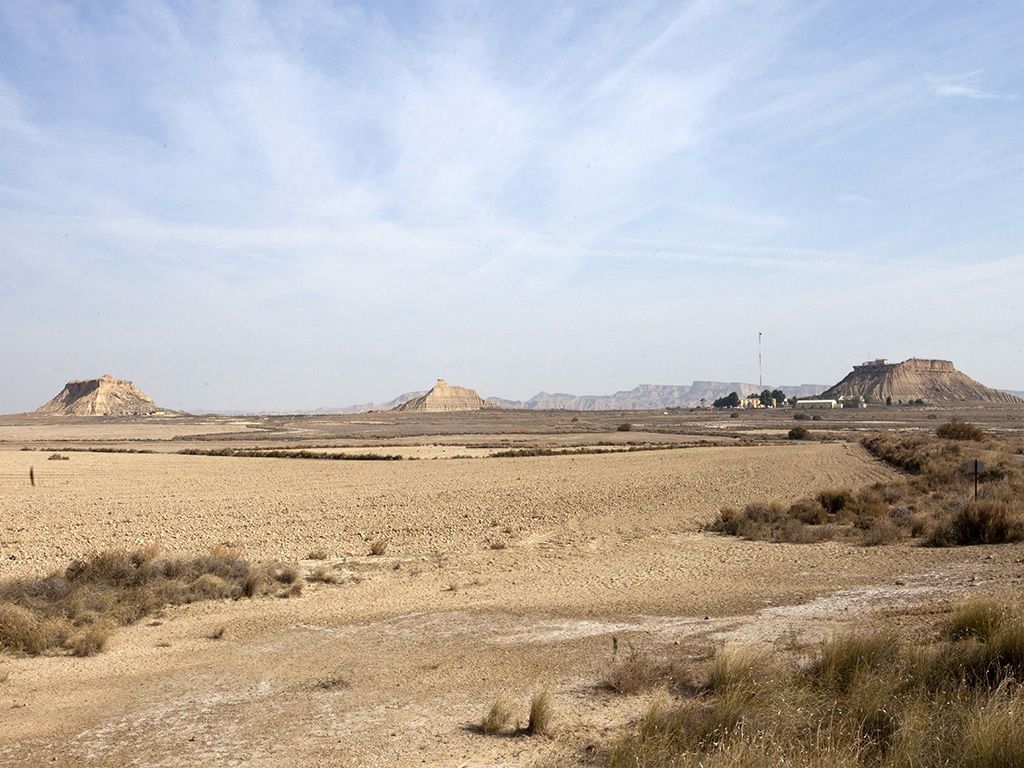
Audio 4. LOS BLANQUIZALES (“THE BADLANDS”)
We now find ourselves with the audioguide in Los Blanquizales, or in English, The Badlands. Lakota, an Indian of the Sioux Tribe, named this type of topography “mako sica,” literally, “bad lands”. The land reminds one of a lunar landscape, with its sparce vegetation, and a major facelift that has contributed to the formation of deep gullies in the soft rock (clay, marl, gypsum).
With careful observation, one can see how there is a similar colour to all of the Badlands layers, except for one, where redder materials (belonging to the Quatenary Period), are located below whiter and older material (from the Tertiary Period). Why would older material be on top of newer when it ought to be the opposite? It’s because there have been further periods of erosion and sedimentation which have transported material to lower areas, which otherwise would be higher, and vice-versa. This geomorphic phenomenon is called discordance.
Vegetation in the Badlands is very scarce on account of the lack of soil, being mostly grass and sisal.
Where the soil is in a state of regeneration, one can find ontinas, together with sisal and grass in a larger quantity than before. We can also see murages, a plant commonly used as a healer, but nevertheless very poisonous if taken internally.
We need to take care not to step on and to not touch the Limonium, a herb local to the Ebro Valley. This is a perennial herb, visible in spring by its small, pink flowers. In the winter, there are only leaves at ground level.
The birds of Bardenas are very difficult to see on account of their ability to blend in with the terrain. However, if we stop the audioguide and listen carefully, we can hear different species such as larks, terreras, curlew, little bustard, sandgrouse or ganga, each with its own particular song.
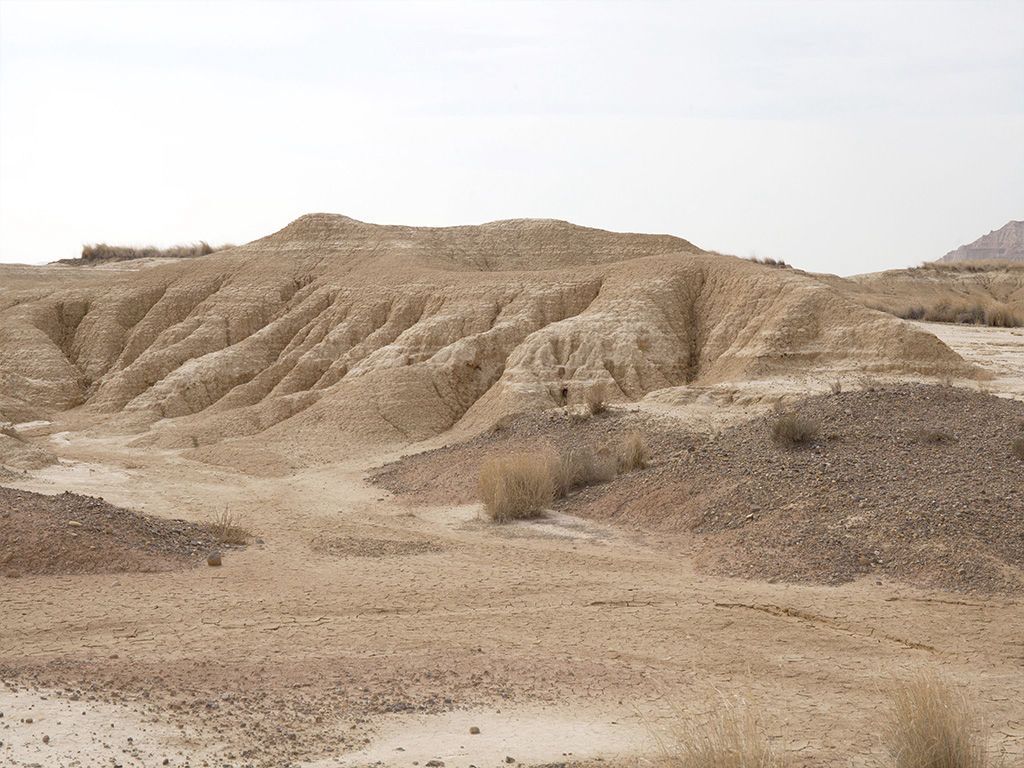
Audio 5. LIVESTOCK FARMING IN BARDENAS
Royal Bardenas of Navarra has, for centuries, not been just a place for grass, but for an important and extensive ranching area, as you are about to discover in this section of the audioguide. Twenty two entities have shared grazing rights in these lands—known as congozantes. Some authors have noted that there were up to 300-thousand heads of cattle here during the Middle Ages.
The first document describing the use of the territory is that issued by King Don Sancho García in 882 AD to the Roncal Valley, recognizing the right to graze and to make corrals and cabins.
Roncal Valley was later accompanied by Salazar Valley, Olive Monastery, and 19 towns of the Navarra riverbank, which were given rights to shared pastoral usage of the land, among other uses.
The first ordinances indisputably reflect the importance of pastoral use with respect to all of the rest (agriculture, fuelwood, mining of stone, lime, gypsum, manure, and so on.) It wasn’t until the beginning of the twentieth century when grazing began a decline and agriculture took over.
It’s estimated that there are some 100-thousand heads grazing in Bardenas during the autumn, mainly sheep.
In years gone by, the grazing year began in September, at which time flocks of sheep, migrating from Pyrenees ports, the Urbasa and Andía ranges, and other grasslands, entered Bardenas.
Ever since the distant past, there has been a ban on cattle staying in the region during the summer.
The main grazing resource that herds find in Bardenas is the stubble left over after the harvesting of cereal grains.
Grazing was a common use of the ponds, troughs, pastures and sheep folds by shepherds from the 22 organizations, with a corresponding payment of tax. Today, to preserve the natural environment and to use the resources in an orderly manner, they have divided Bardenas into 87 Agricultural Farming and Livestock Farming districts.
The breed of sheep of Royal Bardenas is the Navarra Grazer, originally from the Roncal and Salazar valley in the Pyrenees. Formerly listed as triple capacity (meat, milk and Wood), today sheep are primarily used for meat. It is known as ternasco, or “suckling lamb”.
In the past, wool was also an indispensable source of income in the farming household economy. Today, this activity results in more spending than earning. Nevertheless, it is still necessary to sheer the sheep in order to keep the flock clean and to prevent the animals from overheating.
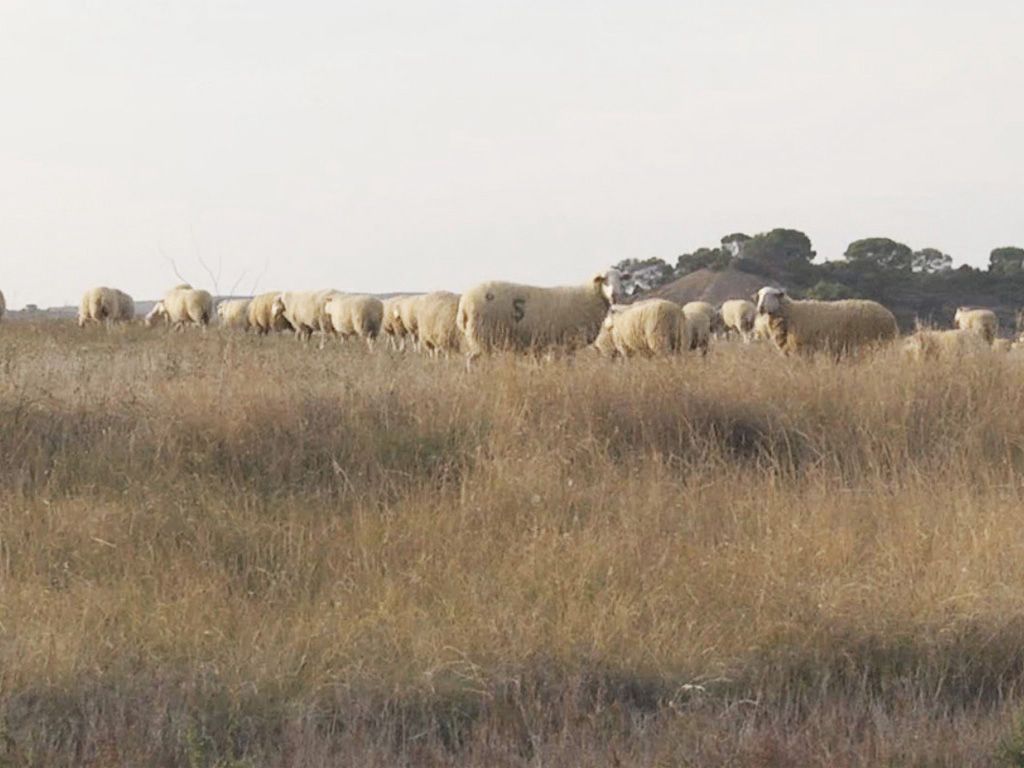
Audio 6. CATTLE TRAILS AND POULTRY IN ZAPATA
Next section of this audioguide, the cattle trails are traditional travel routes which cattle have taken. In Spain, they are a public convenience and have come to reach a total of 125-thousand kilometres in length, about 425 hectares in area—that is to say, one percent of the territory of the country.
Depending on their size from largest to smallest, they are classified as true ravines, (wider than 40 meters), Crossbeams, Passes, and Branches. Rain-keepers and drinking troughs can also be attached to them. The cattle route par excellence is the Cañada Real de los Roncaleses—The Royal Gorge of the Roncaleses, which crosses the nature park from north to south, and which in places meets up with our tour of Bardenas.
Pens and barriers are traditional pieces of construction dealing with migratory livestock. Zapata Corral is a good example. These buildings always have a section under a roof (called the cover), and normally another unroofed attachment (called el serenado, or “ the calmed one). This part is simpler and only consists of a wall enclosure or metal mesh.
Historically, the owner of the corral or barrier maintained the rights of its usage, but any other rancher could make use of the building if it was empty. The only requirement was to first notify the owner, who could not object.
The buildings are the property of their builders, but always “a precario”—in a state of ambiguity (the ground always belonging to the Community of Bardenas).
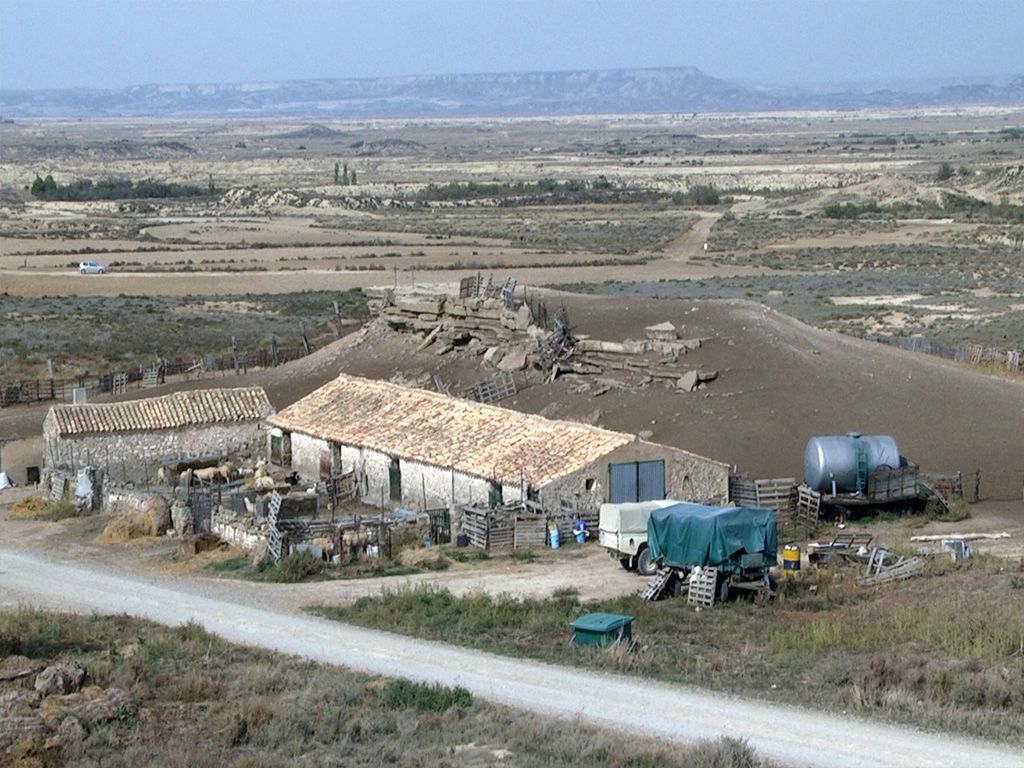
Audio 7. ZAPATA RESERVOIR
Along with the corral, within the military zone, we can see with the audioguide Zapata Reservoir. Access to the public is prohibited. The reservoir provides the water to irrigate a number of plots of land. It receives water from the irrigation ditch of the Five Towns by way of various ravines.
There is a healthy population of Tench (a type of fish), and it is used as a nursery, to reinforce their numbers in the market and in other bodies of water.
Surrounding Zapata Reservoir, we find salt marshes, composed of small, fleshy shrubs, such as soda bushes, shrubs with succulent leaves, and the orgaza shrub. Also, there are tamarisk, reeds and rushes which almost completely surround the reservoir. In the deepest areas, there are reeds and cattails or bulrushes.
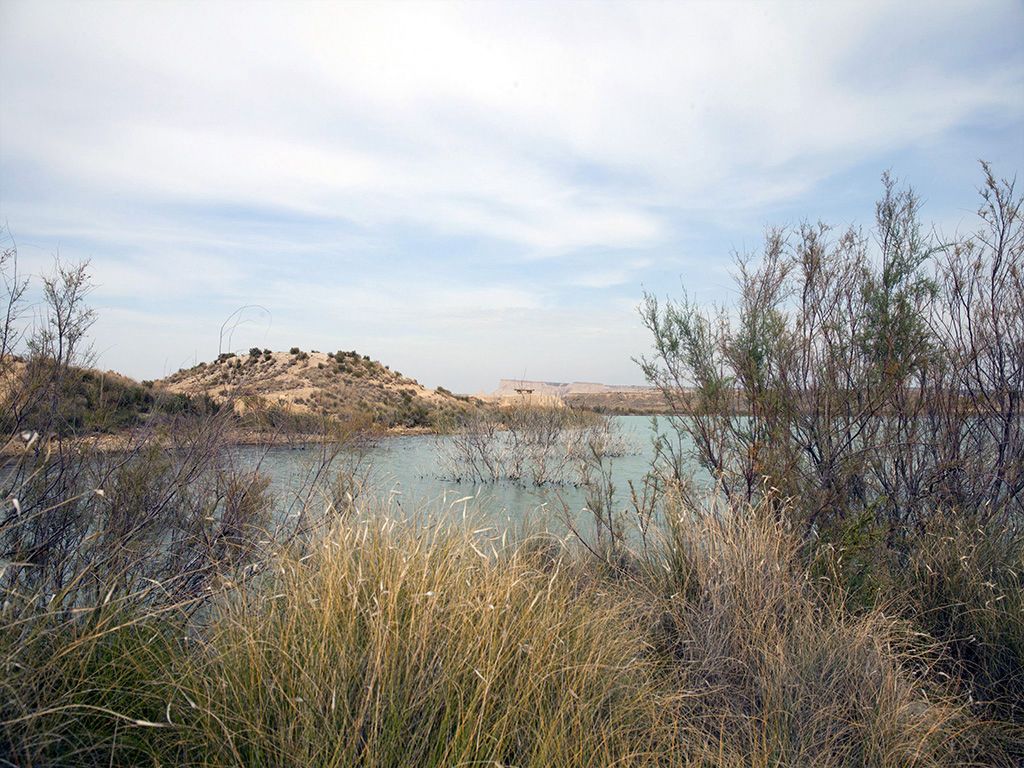
Audio 8. THE ROYAL GORGE OF THE RONCALESES
The royal gorges are considered to be the principle routes of the network. They connected the summer mountain pastures with the wintering areas of Las Vegas, and other lowlands.
The Royal Gorge of the Roncaleses, in which we are moving at this moment with the audioguide, at 131 kilometres, is the easternmost, and connects the Pyrenean pastures of the Roncal region with Bardenas. The borders of the gorge are marked by concrete monuments about 40 centimetres in height, with the inscription, “Cda”. These are situated in pairs which face each other on either side of the gorge. When we pay attention while listening to the audioguide, we can see them along the route to Rincón de las Rallas (the corner of scratches).
The Royal Gorge of Murillo el Fruto to Salazar, 95 kilometres in length, runs parallel to the Royal Gorge of Roncaleses, from north to south.
The place in which we find ourselves at this moment with the audioguide is known as “La Cruceta” (The Cross), as this is where two major cattle trails intersect—the Royal Gorge of Roncaleses and La Traviesa, or Crossbeam Number 2.
Migration towards the south (descending migration) began in mid September. The reverse trek, back to the valleys, began in the second half of May. Shepherds left their villages in stages, in order to avoid the herds mixing together on the road.
They used to have to pay a fee which was set by the different towns they would pass by---feeding, watering and resting their livestock.
The herd is led by chotos, goats that wear large cowbells. Along the entire route, the shepherds had to watch over the areas where the herd was grazing: on some days the grass was sparse, but on others, if there were uncollected cereal grains, the shepherds would have to make sure that the herd didn’t eat a lot due to the danger of indigestion.
Century after century, as if it were a predetermined ritual, the tradition had been repeated until a few decades ago when changes were made: before, the whole flock would walk to the pastureland. Today, many of the ranchers move the herds in trucks; before, the ravines were passable roads, but today, numerous stretches have disappeared with the reclamation of new lands, construction of infrastructure, and so on.
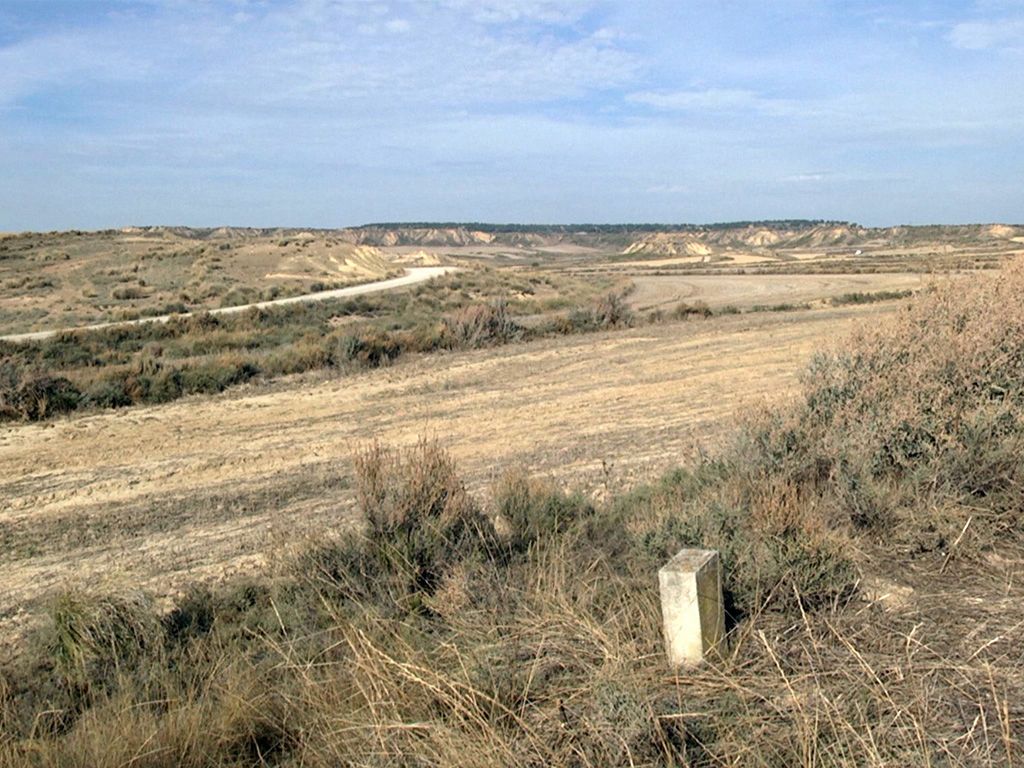
Audio 9. THE CORNER OF SCRATCHES, IRRITATION AND SANCHICORROTA PEAK
These places of huge cliffs and great scenic attraction that we can now see with the audioguide, are of the utmost importance with respect to the rupiculous (or rock-dwelling) birds of Bardenas. It’s not for nothing that the heart of the Special Protection Zone for Birds is called The High White Plain. Cliff-nesting raptors are the most outstanding birds in this area. During breeding months, there is a temporary restriction in order to avoid human presence. The aim is to provide a tranquil environment for the birds during this crucial breeding season.
Birds of significance in this area include populations of the Egyptian Vulture, the Golden Eagle, owls and other vultures. We can also find crows, kestrels, the rid-billed chough, and the black wheatear, among others.
Sanchicorrota hill, at a height of 425 meters, is a very distinct and elegant peak, which has the typical typology of Bardenas hillocks. On its top, one finds the Ruins of Sanchicorrota Castle. The ruins are consist of an enclosure wall built with masonry 60 centimetres thick, a small medieval building with thick concrete, and a rectangular underground chamber formed with stones and covered with a pointed vault.
It is thought that the function of Sanchicorrota Castle was to protect the residents of the area from enemy attack. The small, underground room was undoubtedly a “dungeon of oblivion” where prisoners were taken and left to die of starvation.
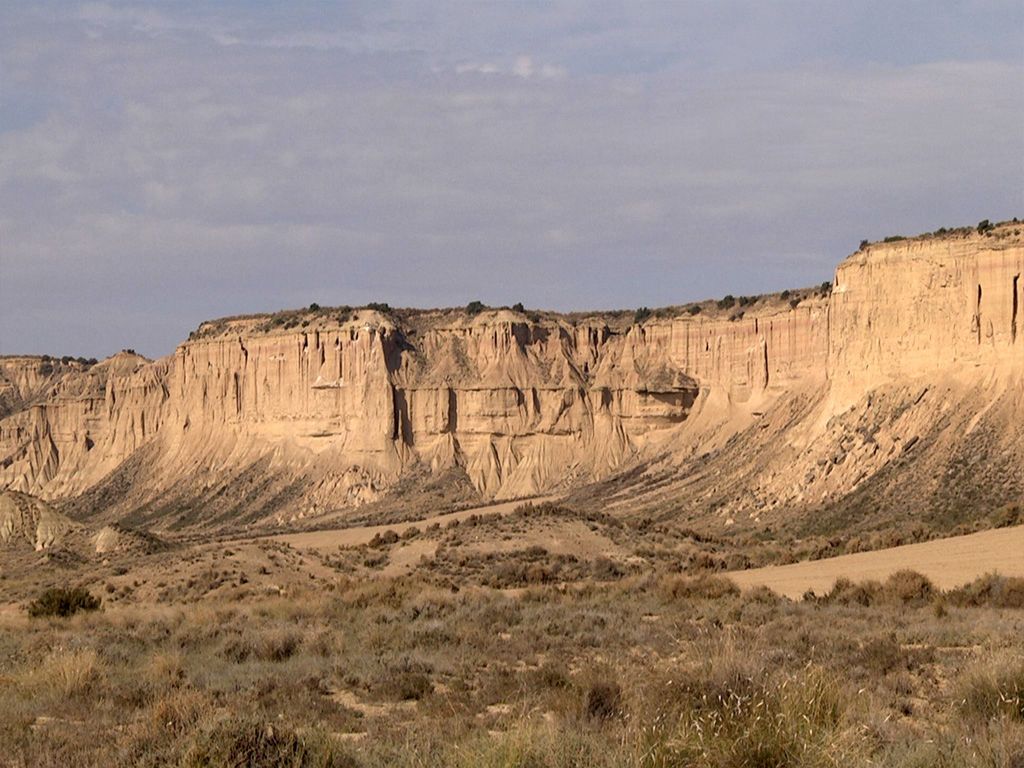
Audio 10. BANDITS AND WRONGDOERS IN BARDENAS
It is known that in the time of Sancho the Strong, bandits and former soldiers that fought in the Aragón and Castilla wars took refuge in Bardenas.
Legend has it that, in the Middle Ages, Bardenas was a vast, almost uninhabited territory. It was a safe-haven for robbers, bandits and other unsavoury individuals, and the scene of numerous assaults, as you will discover in this section of the audioguide. The situation led to a dozen neighbouring towns in Navarra and Aragón creating a brotherhood of defence in 1302. Part of their manifesto reads, “Upon catching the wrongdoers red-handed, they will be hanged without awaiting the order of the King nor of the Justice.”
In the fifteenth century, the most feared bandit was Sancho de Rota (Sanchicorrota), who called himself “King of Bardenas”. He was accompanied by his cadre of 30 bandits on horseback. In order to shake-off pursuers, their horses’ shoes were put on backwards. His legend is one of bravery and craftiness.
Insecurity in the region became so great that King Juan II organized a party of 200 men to look for him. By 1452, they had done away with all of the bandits with the exception of Sanchicorrota. Upon being surrounded on his mountain, he took his own life with a knife. After passing through Arguedas, Valtierra and other villages, his body was put on display in Tudela on a gallows for public derision.
Sanchicorrota enjoyed a favourable reputation, including being called the Bardenero Robin Hood. They say he stole from the rich and gave to the poor—chroniclers also say that he was very courteous to those he robbed.
In the following centuries, one of the bloodiest bandits was Marcuello. He attacked the Palace of the Squires in Mélida, and after the robbery, he burned the owner alive. They were persecuted, imprisoned and quartered on a Bardenas road, today known as The Way of the Fourth.
There is also the famous bandit, “Moneos,” who was finally captured after robbing a stagecoach with a cargo of hake fish. They found him by trailing the smell of fish.
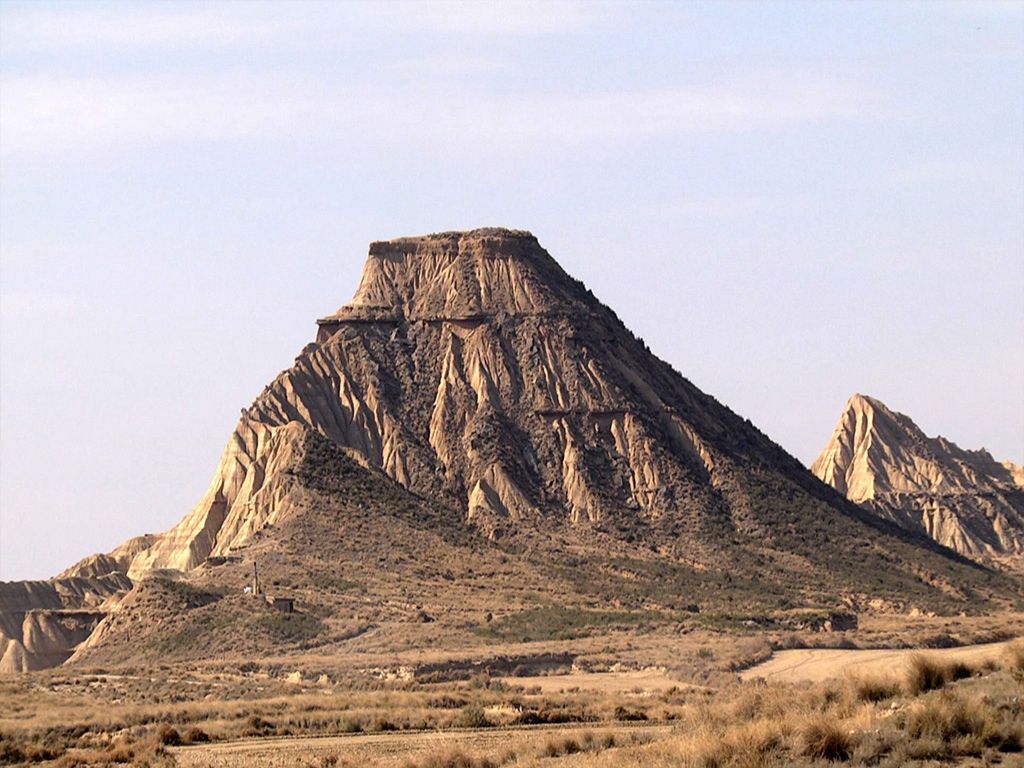
Audio 11. JUAN OBISPO LOOKOUT
Before enjoying this stop with the audioguide, we want to warn you to be extra careful and not to approach the edges of the viewpoint, as they are unstable.
Juan Obispo Lookout is a unique vantage point. It allows us to see the two types of landscape that have characterized Bardenas since days long gone by: On one side, the tabular landscape where el Rallón and la Ralla (to our right) and Pisquerra (in front) are the highest points; on the other side, the rain-fed agricultural landscape as well as the natural vegetation in the military zone.
Leaving behind the legends that tell of the existence of great forests, the potential vegetation of Bardenas—that is—the maximum level of vegetation that would exist if human influence were to cease, would not be at the forest level. The most we could expect would be tall bushes or other smaller-sized vegetation. The military zone contains a first phase of this “potential vegetation”. The “Ontinar-Sisallar” occupies a large part of the land there.
At the same time, we cannot forget that successive fires over the centuries, logging and firewood harvesting, charcoal production, harvesting straw for the manufacture of pulp, along with other uses now discontinued, have all had an impact on the vegetation.
From our viewpoint, we can see the majority of the plant species that are found in this nature park. These are:
- Clumps of tamarisk—for example, in the ponds that we can see at the base of Juan Obispo hill.
- Thyme and Rosemary bushes, which form a mosaic with laston on the small hills around the gazebo, and inside the military zone where there is open scrub, where the ontina and sissal usually dominate (darker and grayer patches).
- Grasslands. These are the harder grasses that form yellower patches than the others.
- Vegetation found in salt marshes and ponds.
- And, finally, the agrarian landscape.

Audio 12. FARMLAND
In Bardenas, farmers practice a biennial crop rotation called “Year and Time”: cereal one year, fallow or giving the land a rest on the other. This is the old Mediterranean system practised by the Greeks and Romans. Generally it meant that the land was divided into two parcels, one to be cultivated while the other was left fallow. The latter provided livestock a place to feed in a natural way.
In Bardenas, dry crops represents 47 percent of the agricultural land, barley being the principle grain cultivated here, for its capacity to survive difficult growing conditions.
Draft animals were essential in traditional agriculture. The use of animal power was common up until the 1940s. With each piece of equipment, animals were fitted with complex harnesses.
By the mid Twentieth Century, farmers saw the arrival of the first tractors with iron wheels, planters, harvesters, fertilizer spreaders, cutters and winnowers. This made the work easier, reducing the number of people needed for each job and saving time.
Field preparation required that, before planting could be carried out, land that had lain fallow had to be prepared. Fertilizing the land was another necessary task. Manure was used with orchards and vineyards. Over the drylands, fertilizer was sparingly distributed. The arrival of chemical fertilizers brought about an increase in the performance of the land.
Once the land was prepared, it was time to plant. This began on All Saints Day in November. Until the 1950’s, the grain harvest began in June. First barley, then wheat and then, finally, oats. A sickle was used.
The reapers, sometimes hired labourers, were contracted specifically for the harvest, and from as far away as Valencia.
After the harvest, less affluent families came to glean in the fields. This meant collecting the ears of corn after the farmers would have officially ended the harvest. On numerous occasions, the whole family would travel for a month or two, with the mother and children being very involved.
After the reaping, the harvest was taken in for threshing, to separate the wheat from the chaff.
The audioguide continues in the next section.
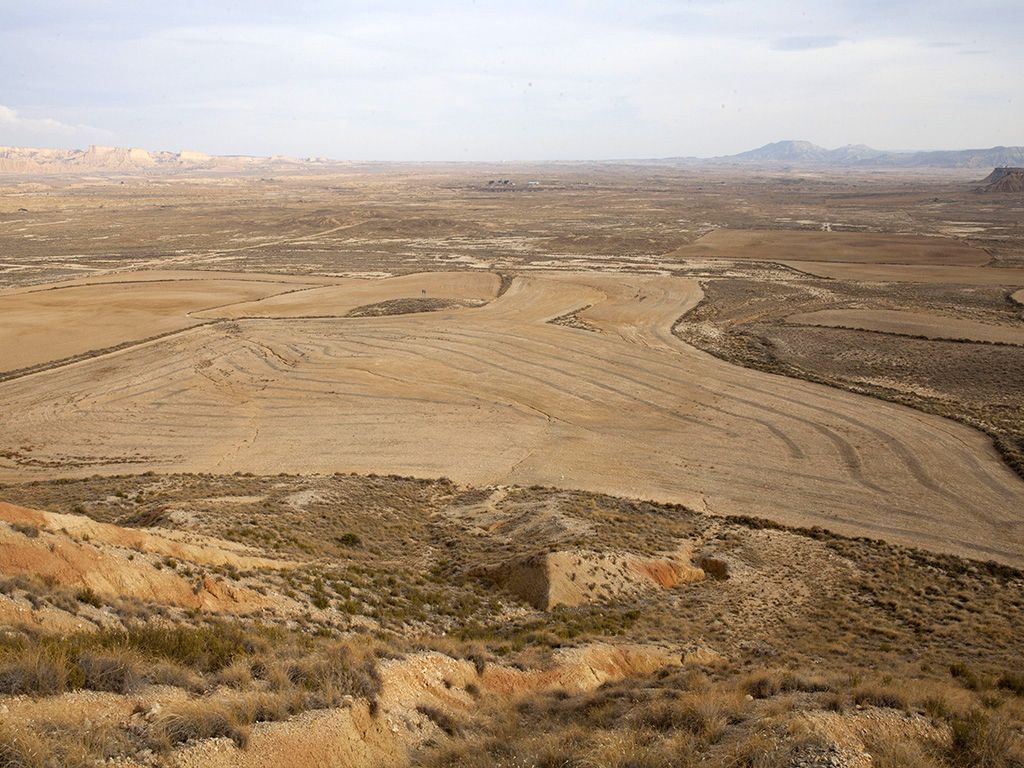
Audio 13. THE BADLANDS OF PISQUERRA
We find Badlands formations in several parts of the central zone of the Nature Park. However, there are a number of places where the formations have reached a high degree of maturity.
The high susceptibility to erosion of the badlands substrata has resulted in very fragile formations that have taken millions of years to form. Attempting to climb on one, or simply pulling out one of the plants that helps hold their surface structure together, will increase the speed at which the rain and wind do their eroding day after day.
The Badlands of Pisquerra have been an obligatory stop. Because of their fragility, we advise our visitors to remain on the marked path.
This area of the badlands brings us closer to one of the points of greatest accumulation of salt (calcium carbonate) which gives a white colour to the central depression, known as Bardena Blanca, or “White Bardena”, and is really worth mentioning in this audioguide. These salt “crusts” are the result of the combination of the abundant salt and gypsum in the geological substrata, and the arid climate. When it rains, the salt in the substrata dissolves in the rainwater. Because of the heat and sunlight, the salt is quickly deposited on the surface, each time the deposit becoming thicker. These salt crusts are not always visible. It depends on the time of year, the amount of rain over the previous days, sunlight, and so on.
The abundance of salt has a negative effect on crops in the area. The salt prevents roots from absorbing water, and in many cases becomes toxic.
Some plants, called xeric, (meaning able to survive in an arid habitat) have developed structures that allow them to avoid drying out: insulating thick cuticles, hairs or fluffs, scales, thorns, extensive roots. Other species stay in a seed form until the first rains, or bloom in winter when there is more moisture.
Halophytes, meaning salt plants, have gone a little further. Many allow salt to accumulate in their interior, which results in water being absorbed from outside. Many have glands that excrete salt, and many store water inside, such as the cactus.
In Bardenas, we find species displaying a number of these adaptations.
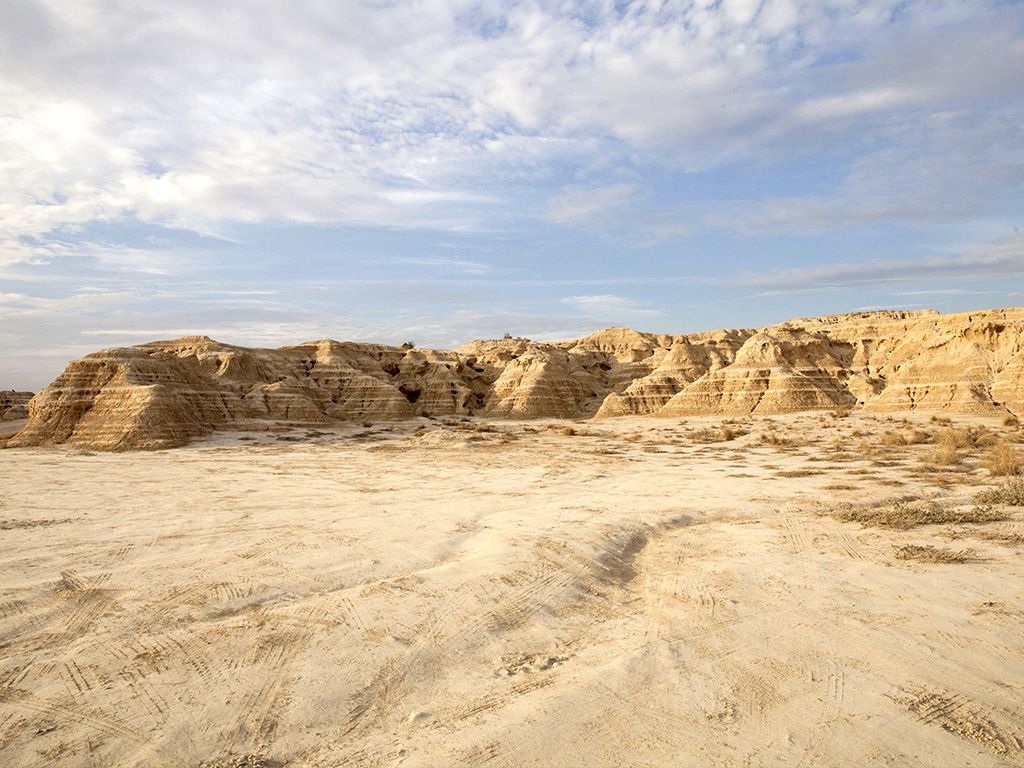
Audio 14. RASO DE LA JUNTA (THE PLANE OF THE COALITION)
The point where we are about to cross with the audioguide has received the name “La Junta” (a coalition or splinter group). Geologically speaking, the hills that we leave to our right are called “losados” (or “paving stones”) owing to the high number of slabs of sandstone that have fallen on the slopes. Little by little, the clay from the lower layers disappeared, leaving the sandstone hanging in the air, until its own weight caused it to break and fall. The fact that the number of falls of sandstone on the sides is so high reveals that the hills used to be significantly higher and wider than they are today.
The name “La Junta” comes from this being a place where ancient juntas used to come together to resolve conflicts between the congozantes, who shared the land to graze cattle.
In the early days, managing the territory was a direct responsibility of the king. Later, towns organized their own occasional meetings to resolve conflicts, sometimes in collaboration with, and sometimes in opposition to, the representation of the Crown.
The bloody confrontation that occurred in the Fifteenth Century between Tudela and Roncal Valley, resulted in King Don Juan and Queen Doña Catalina declaring in 1499 that people should exercise their own rights. This royal judgement is considered to be the first step in what would later become “The Ordinances.”
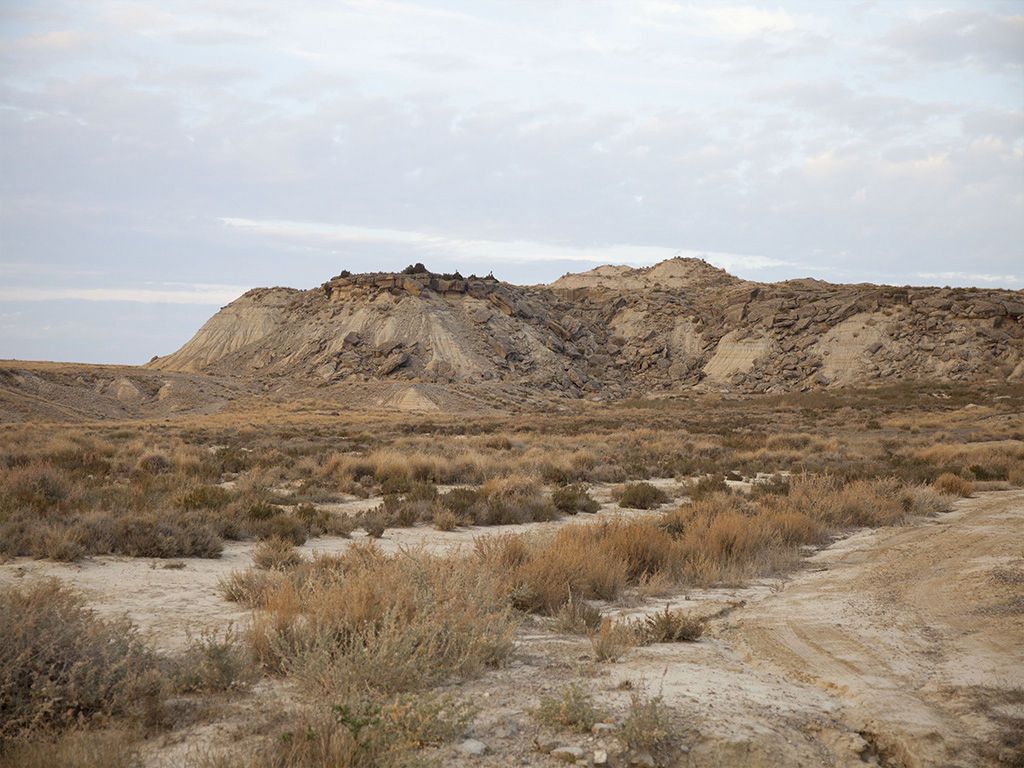
Audio 15. EGUARAS PRESERVE
If we look towards the northeast with the audioguide, over the cabin, we can see Eguaras Preserve. It is a Natural Reserve, located in the municipality of Valtierra. It does not belong to the Nature Park.
The ruins of Peňaflor Castle arise in Eguaras Preserve. The castle was built by Sancho el Fuerte (Sancho the Strong) in the Thirteenth Century with the aim of reinforcing the Navarro-Aragon border, fighting the groups of bandits that plagued these lands.
According to legend, it was here that Doña Blanca de Navarra, Princess of Viana, daughter of King Juan II The Bad, was kept prisoner. She did not want to marry the prince of Aragón. This was at the end of the Fifteenth Century. The king kept her locked up in the castle tower with only bread and water. Every night, a shepherd of Valtierra, who had sheep in the area, brought her cheese and milk, and so the princess could cope better with her punishment. Years later, as a means of gratitude, Doña Blanca gave the lands which surrounded the castle to the shepherd. This explains why, according to popular belief, these lands, even today, belong to the municipality of Valtierra rather than to Bardenas.
Eguaras Preserve has always been a private property. At first, it belonged to the kings of Navarra, who used it as a hunting area. By 1530, it was owned by Juan Eguaras, a nobleman of Tudela, where this enclave gets its name. Today, the main use for the farm is agriculture.
From an ecological point of view, Eguaras Preserve coincides with a depression in the land. It appears to be an oasis in the middle of the steppes. Over the centuries, dense Mediterranean vegetation has grown here, composed mainly of Aleppo Pine, and other endemic species such as sisal, tamarisk, ontinar and mastic. There are also reeds, grasses and shrubs which provide shelter for a number of reptiles as well as medium-sized mammals, such as the hare, rabbit and wild boar. Where the plane cuts in like a natural wall, vultures, the Egyptian Vulture and the Golden Eager make their nests.
Besides its natural richness, Eguaras Preserve offers stunning panoramas. Without doubt, it being a private property has helped in the proper conservation of the Aleppo pine forest, which we can enjoy today.
The fortress we can see with the audioguide had a main tower, which is still preserved, as well as three smaller towers. Aside from the walls that crowned the hill, there was a barbican (or second wall) where livestock were kept. South of the tower there was a cistern, insulated with bitumen, used to store water.
The principle mission of this fortress, as with the other in Bardenas, was to provide a watch over the area, warning of any enemy presence, usually by way of smoke signals.
Notwithstanding the state of ruin it finds itself in, Peñaflor has the distinction of being the only medieval castle not to undergo modifications since its construction in the Thirteenth Century.
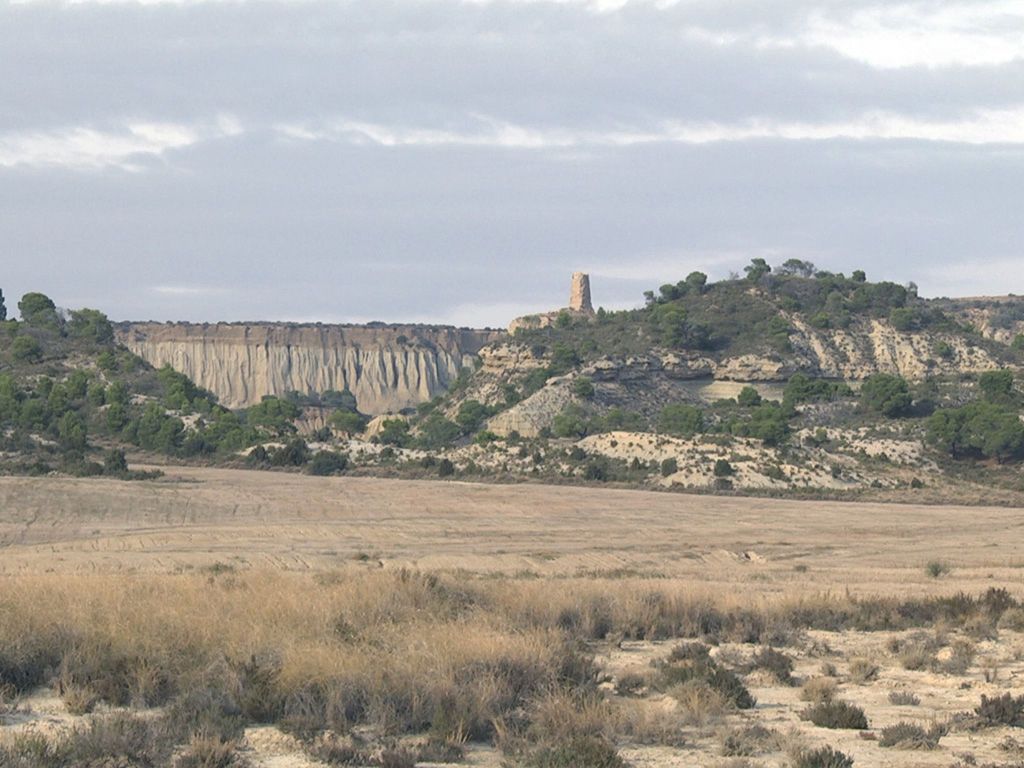
Audio 16. THE CABINS
The Bardenas landscape also includes a number of buildings whose use was largely agricultural. This is the case with the cabins that you can see with the audioguide. Originally, they were temporary housing-- shelters put up for farmers and their horses, also used to store seeds and farm equipment. The arrival of the tractor and combine dramatically reduced the time needed for the work, and the cabins were abandoned.
Its structure is very simple: two rooms, kitchen and stable, and one single entryway that was always to remain open (although, since 1926, it could be closed). Most had a small pond nearby in which to store rainwater. Both men and animals drank from this water. Other cabins had a cistern—a small hole filled with runoff water—for human consumption.
In the background, we can see the Estroza landscape, which stands upon Bardena Blanca. It reaches an average height of about 480 metres. In the escarpment that forms, one can observe a series of clays in which layers of gypsum, limestone and sandstone are interspersed. Crowning the spur is a level of gravel, sand and silt up to 10 metres thick. This forms the highest suspended terrace over the Aragón River. “Caliches,” a type of calcareous crust, has formed on top.
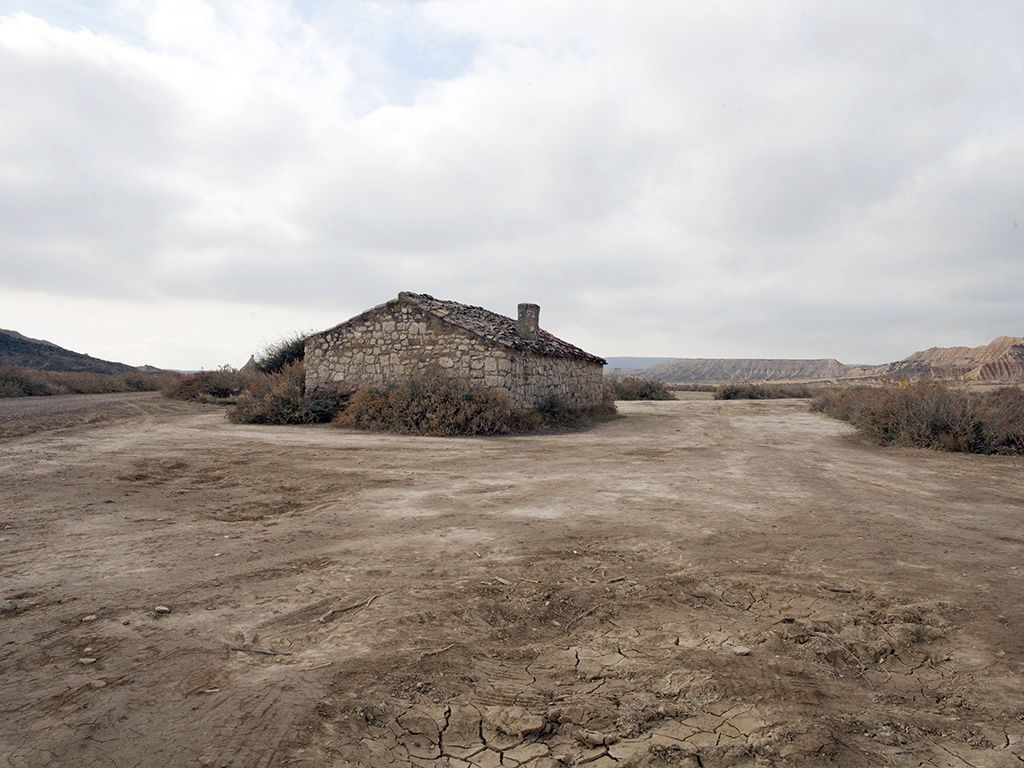
Audio 17. CASTILDETIERRA HILL
Castildetierra hill or hillock, in Blanca Baja, is a unique geological formation in Navarra, of special interest for its scenic and educational value. It serves as a model that explains the high amount of erosion that takes place in Bardenas.
Castildetierra Hill is a “Fairy Chimney”. This is a great column of natural, soft rock, generally made up of sedimentary material—clay, or shale and marl. The top is formed by a more-resistant sandstone rock, which serves to protect the column from erosion. This height of this type of formation ranges from that of a man, up to that of a ten-story building. The variety of colours comes from the different minerals that make up the structure. Predominant erosive agents on Castildetierra Hill are the forces of rain and wind in the area, known as el cierzo—the north wind. We can see significant gullies in the lower part of the structure. In order to avoid further deterioration, we must admire this work of nature from a few metres away.
Surrounding Castildetierra with the audioguide, we can observe small hills called “triangular sides” whose slopes give us an idea of their origin. If we could fill all of the ground between the “triangular sides” and Castildetierra, we would have reconstructed the original mountain.
If we set our sights to the distance, to the right of the natural monument, we see an ancient “fairy chimney,” of which only the bottom of a pyramid shape remains. Is this the future of Castildetierra?
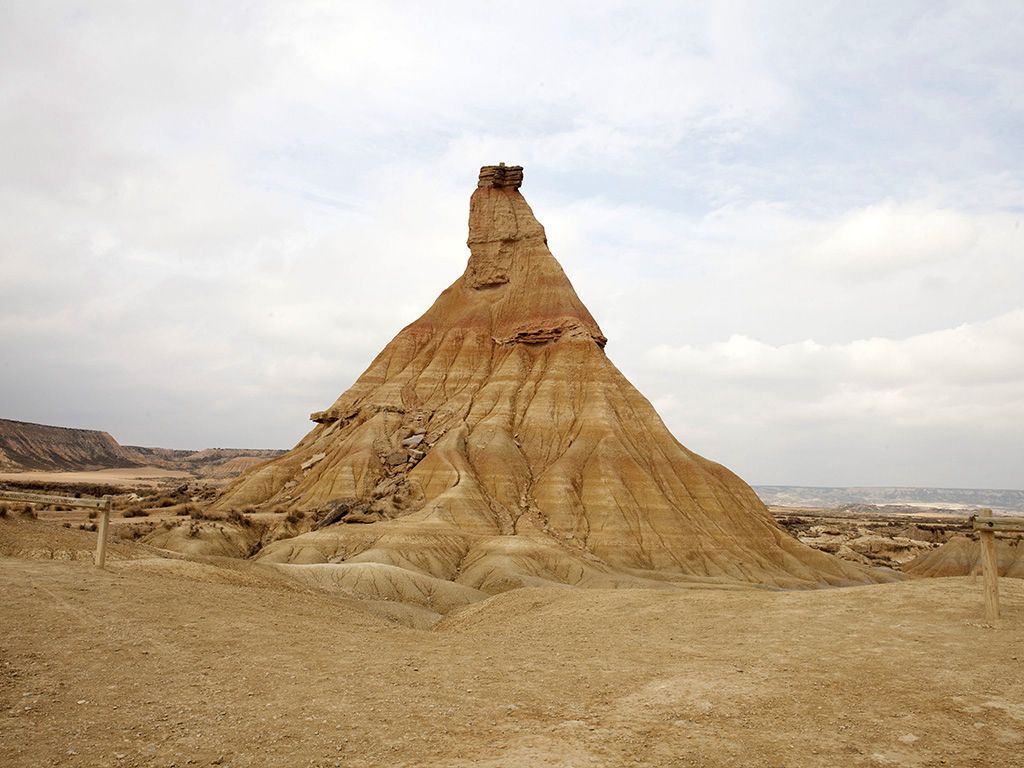
Audio 18. THE RAVINES OF CURTAINS
Before enjoying this stop with the audioguide, we want to advise you to be very careful and not to get near the edges of the ravine.
The ravines are elements of Bardenas landscape that have their own life: life that is born, grows, reproduces and dies in another ravine, or in the Ebro River. It is a very dynamic and changing model, owing mainly to the process of water erosion. Studies show that nearly one hundred tons of material per hectare are eroded each year.
At the bottom of the ravine, we see a superficial “structural crust”. This crust is formed by sediments that have been washed away by the current on account of rain. We can also observe a large group of tamarisk-- shrubs that are resistant to drought and salty soils. Tamarisks are frequent in areas which are temporarily waterlogged. The name means, “You are my support,” as tamarisk was used to strengthen dunes and sandy slopes along the coasts and rivers. Its branches and bark were boiled and used as a folk medicine to treat diarrhoea.
Going up the ravine we find sisal, often growing in soil which is rich in salt and nitrogen—the latter due to the droppings of cattle and from crops. They are grazed upon by sheep, which in turn help to spread them.
If we are fortunate during our walk through the ravine, we can observe various birds, such as the black redstart, the bee-eater, the linnet and the wheatear.
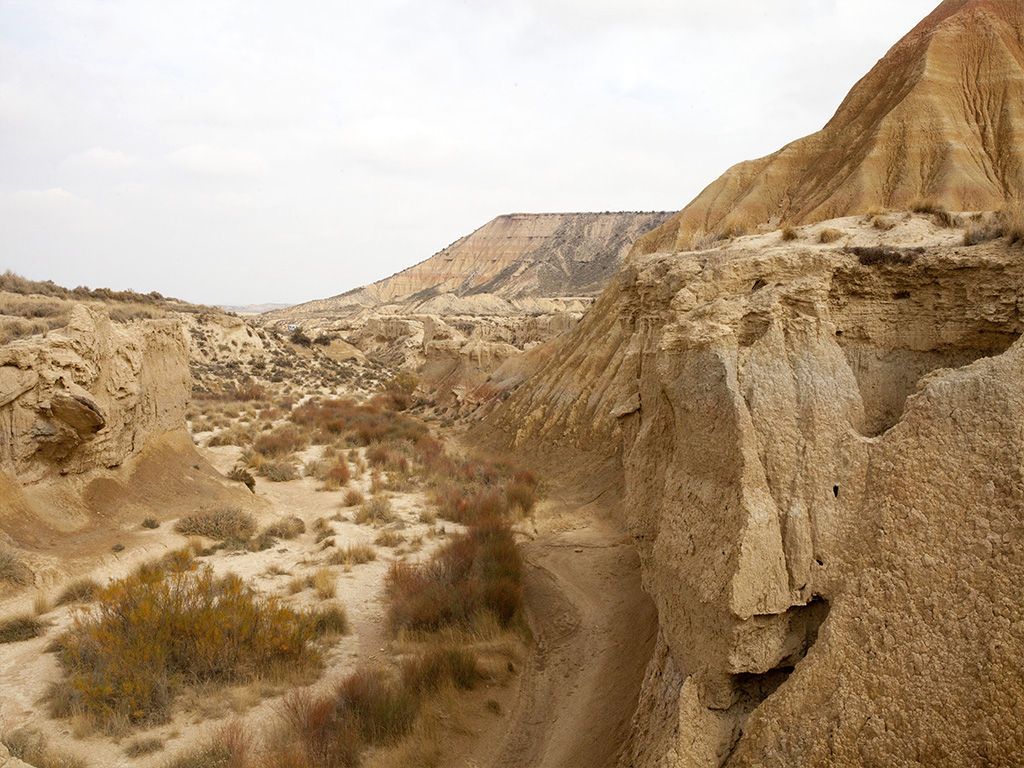
Audio 19. THE RESERVOIR AND THE HILLOCK OF THE CURTAINS
Despite what it may seem like at first glance, Bardenas is not a desert. There are in fact numerous wet regions in the tablelands that sustain botanical and animal communities of great diversity and complexity. Most of the ponds and reservoirs in Bardenas are man-made, but with the passage of time they have been naturalized, as in the case of the Reservoir of the Curtains, an ideal representation of a typical endorheic system—a system with no outlet river, typical in the Ebro Valley. It naturally attracts an animal community whose survival depends upon the resources provided by the wetland. It is of great ecological value in that it contains all of the levels of vegetation—underwater, amphibious and emerging. The Reservoir of Curtains provides a biological balance to an ecological area larger than its own moist environment.
The vegetation of the ponds in Bardenas presents a curious ring of distribution, nurturing different species according to the level of salinity and moisture.
With respect to the Reservoir of Curtains, we find four marked rings of vegetation.
Salt Marshes: These are composed of small fleshy shrubs, such as soda shrub, “shrub of succulent leaves,” and salt bush shrub.
Tamarisk: There is a dense thicket of tamarisk that almost completely surrounds the reservoir.
Sedge and reedbeds: these also appear to form a belt, next to the tamarisk. In the deepest parts, reeds and cattails or bulrushes appear.
Permanent water: where one can see pondweed.
The Hillock of Curtains and the areas of gullies along its side, owe their name to their resemblance to curtains or drapes. On the outskirts of the hill, there is a remarkable predominance of clear scrub, consisting of typical aromatic plants, such as rosemary and thyme, together with others such as the horehound. There are also a number of grasses, among which is esparto grass. We also find vegetation which is endemic to the arid spaces of the peninsula, such as the dandy lion, limonium, and sisal.
Among the birds that can be seen in the Curtains area and worth mentioning in the audioguide are the marsh harrier, and, especially, coots and several species of waterfowl and waders.
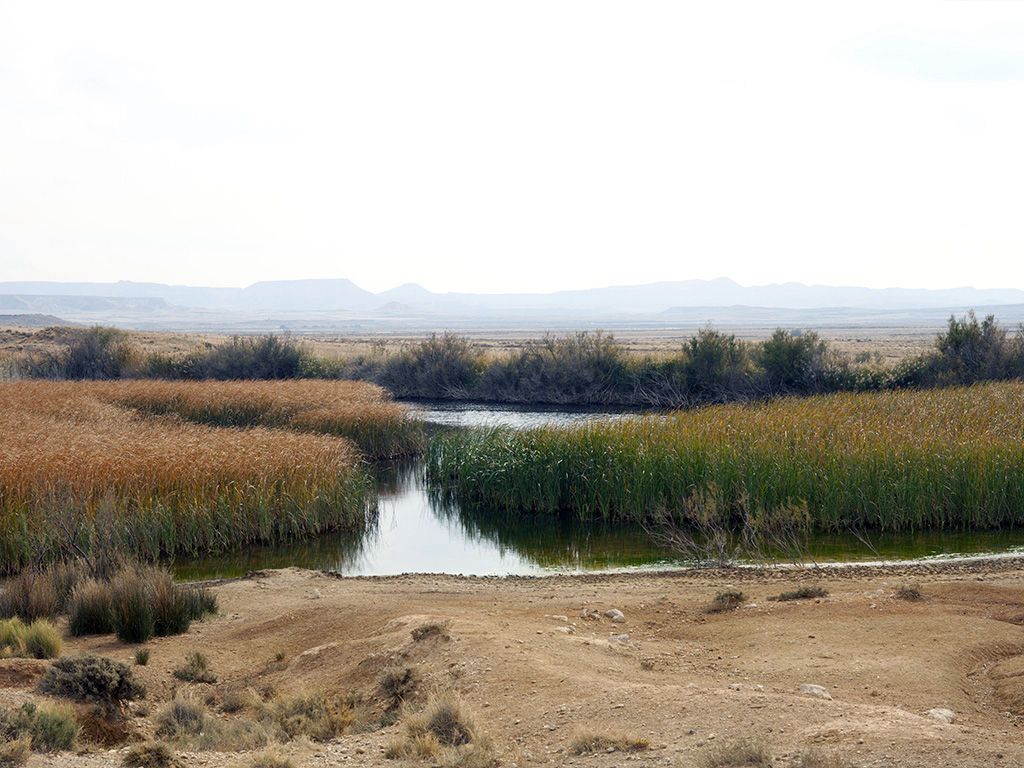
Audio 20. THE HILLOCK OF CURTAINS
The hillock of Curtains is a model witness of a Bardenas hill, in that we can identify different layers of sedimentation by the colours. The arrangement of these layers and their composition involves a floral community and characteristic fauna.
In the layers, we can distinguish its composites of shale, marl, sandstone and gypsum. The reddish colour indicates the oxidation of iron in the deposits, due to the high ambient temperature.
At the top of the hills, erosion has made it flowingly smooth. On the sides, the effect of sunshine and shade is very palpable. Erosion on the slopes receiving direct sunlight is very strong, creating very deep gullies that form bad-lands (blanquizales) or scarpes. In the shade, there is more vegetation, leaving it smoother. There is less erosion here and the erosion is more of an even nature, although it still continues to be fairly intense.
Curtains is the only hillock which gives people permission to ascend to the top. One can reach a height of 370 metres above sea level. It juts some 65 metres over the ravine that stretches around it. The 360-degree panoramic view that we have with the audioguide from the top of Cortinillas is exceptional and allows one to see the entire series of hills and planes that surround the central depression.
Surrounding the hillock are grasses—indicative of land with poor soil and poor drainage-- and rosemary--indicative of calcareous substrates.
If we remain silent, especially in the spring, we can enjoy the call of the Bee-Eater, the Tawny Pipit, and, with luck and patience, see common and Thekla larks. Hidden in the plants, we find insects such as cicadas, crickets and beetles.
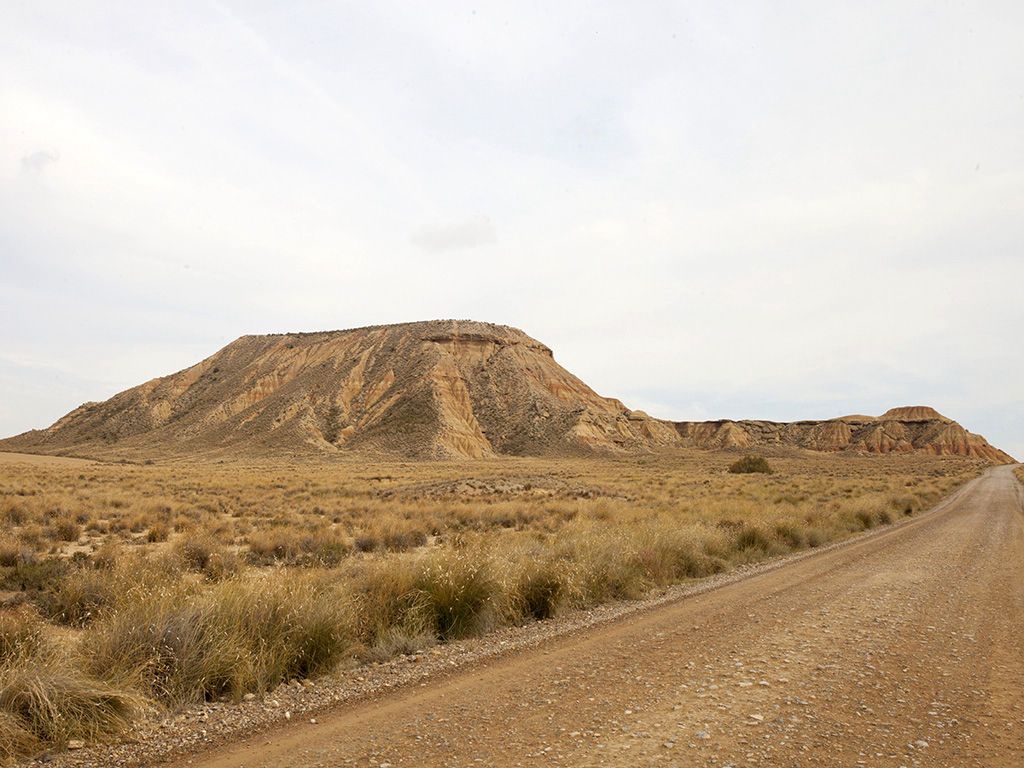
Address: Access to the Information Centre and Natural Park: Entrance from the NA-8712 km. 0.8 (Tudela-Arguedas / Arguedas-Tudela). 31500 - Tudela (Navarra)
- Tel.: 948 830 308 - turismo@bardenasreales.es - www.bardenasreales.es -
Back to index